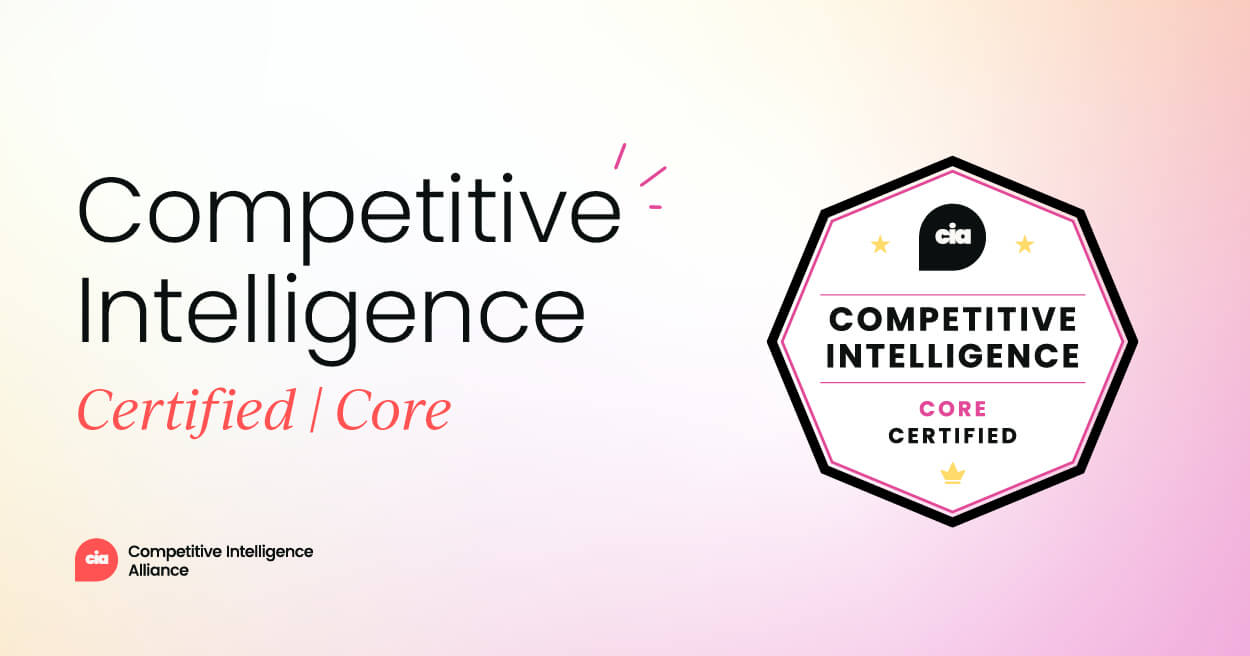Every business aims for a unique position in the market.
However, finding that edge over other products with similar features requires clever analysis and strategic planning.
Without this, you risk a misaligned purpose and your entire product concept can fall flat. Sure you think you’ve got some advantage over other competitors, but that alone isn’t enough.
And let’s be honest: sometimes, it’s hard to compete with businesses that have successfully found their place in the market. More specifically, it’s hard to beat those companies that have achieved what’s known as a sustainable or sustained competitive advantage.
Now, if you’re wondering what we mean by that, stick with us. In this article, we’ll share:
- Why understanding the distinction between competitive and sustainable competitive advantage is key for CI practitioners,
- What leads to long-term success,
- And some ways you can start working towards a sustainable competitive advantage in your specific market.
So, let’s go ahead and start by defining these key terms.
What’s the difference between a competitive and a sustainable competitive advantage?
Put simply, when we talk about competitive advantage, we’re talking about a set of characteristics or capabilities that allow for a specific product or company to outperform others in a similar industry or space. More importantly, you’re at an advantage over competitors when those capabilities address your ideal customers’ needs or you’ve tapped into your niche in the market.
Now, think of sustainable competitive advantage as an extension of the above definition. It’s essentially the same, but competitors in this category are really hard to replicate or beat.
Why?
When you achieve a more long-term position in the market, you’ve likely addressed your unique ideal customer profile’s (ICP) pain points to such a degree that you’re—frankly—in a really healthy place. It’s when you can pinpoint a couple of features or strengths your product has that no one offers the same way or at all.
As in, if you can succinctly explain how those strengths benefit your customers specifically, you’ve likely gone from having an advantage to securing a more stable place in the market.
Why is this type of advantage good to have?
To quote a Harvard Business Review study on sustainable advantage:
“The literature on strategy is crammed with accounts of why a sustainable competitive advantage is A Good Thing To Have. But all those accounts beg two key questions: Which advantages tend to be sustainable, and why?
Sustainable advantages fall into three categories: size in the targeted market, superior access to resources or customers, and restrictions on competitors’ options. Note that these advantages are nonexclusive. They can, and often do, interact. The more of them, the better.”
When we consider closely why those three categories play a crucial role in your business’s success, it’s important to remember that sustainability and endurance in changing market conditions come from your ability to sustain said success.
So, taking those categories to understand how successful companies manage to stay ahead of competition, let’s consider a company like Nike.
Though they might be competing with other companies in a similar market, Nike’s nailed their branding, gathered enough of a low-cost/high-value advantage, and produced some stellar marketing campaigns that consistently stand out. Companies like that won’t just be knocked out of the playing field despite having competitors with similar ICPs.
This is where that sustainability really shines through.
When you’ve established yourself as the leading option for customers, you sit comfortably at the top, and market disruptors aren’t going to shake you out of that position for some time.
It’s going to be especially tougher for smaller companies to outperform a well-established company because of the amount of budget and resources needed to do so. And success doesn’t come without a lot of time, effort, and a really focused and comprehensive competitive strategy in place.

Sometimes it’s better, though, not to obsess over what competitors are doing.
However, even if everchanging market dynamics weren’t to disrupt your place in the landscape:
“[Sustainable advantage] requires constant vigilance, adaptation, and improvement. Companies must continuously monitor market trends, customer preferences, and competitors' actions and be ready to adjust their strategies accordingly.”—Ross Kernez, Forbes Council Member
What are some ways to achieve this sustained edge over competitors?
As we’ve said, maintaining a sustainable competitive advantage isn’t a one-time effort.
Think of companies like Apple, Amazon, and Google. What they’ve achieved in the market isn’t easily imitable, sure, but we can learn from them what’s been done exceptionally well.
Let’s take a peek at what positions a company as a market leader:
- Exceptional customer service or customer-centric culture,
- Consistent brand recognition,
- A pretty solid reputation,
- An ecosystem of products and services,
- And a low-cost advantage.
Of course this varies by business, but if you’ve got the above, you’re set to turn your standard advantages into more long-term ones.
So now let’s look at things to keep in mind when determining where your business sits in the competitive landscape.
Assessing your competitive strengths
Don’t just assume your product’s unique.
Verify it.
For this, you need to first assess your own strengths and weaknesses before you can even think of positioning yourself competitively.
To determine if you’ve achieved a sustainable competitive advantage, ask yourself these questions:
- Can you clearly identify and articulate what sets your product or service apart from competitors?
- Are these differentiators difficult for competitors to replicate?
- Do your customers recognize and value these unique attributes?
- Are you continuously adapting to market changes and customer preferences
- How do you ensure your competitive positioning and messaging is clear despite shifting market dynamics?
Similarly, a good way to track where you stand is to touch base with internal teams. Get them involved in your competitive mapping exercises. This is because cross-collaborating can give you a wider view of your product.
Sales reps, your customer success managers, and marketing strategists can all help shape your competitive strategy.
Another must when assessing your company’s advantages is to stick with simple frameworks. These could really help you find the answers to the questions shared in this section.

How to identify sustainable advantage
As mentioned, frameworks like SWOT, VRIO, and PESTLE can be quite handy when helping you identify your advantages over competitors.
For example, if we follow the VRIO framework, you can narrow down your market research to the very basics of what’s need to outperform your rivals, or at least to give you a clearer picture of where you might fall in the market.
VRIO stands for Value, Rarity, Inimitability, and Organized. What these parts of the framework aim to focus on are
- the value your product provides your costumers,
- whether you possess a rare strength in your unique market,
- if competitors can easily imitate that strength,
- and if your business and teams are organized and ready to position that strength effectively.
Once you’ve gathered as much intel on what sets you apart, you can then develop a long-term growth strategy to keep you ahead.
Here’s what you need to secure that long-term success
Position your product successfully
We’ve said this a few times throughout the article, but sustained success really does boil down to how well you can position your product according to the customers you’re aiming to serve.
Hence, you need a clear, customer-centric strategy. Conduct thorough market research to grasp their needs, pain points, and preferences and then tailor your products and services to meet these specific needs.
And better than your competitors can.
Ensure consistent innovation
What bigger companies get right is consistent innovation, whether through design, updating features, or partnering with the right companies to elevate the customer experience.
Innovation doesn’t always have to cost more resources or time. Simply, companies should invest in conducting the relevant research, updating their competitive strategies or collateral often enough to meet new demands proactively.
This ensures that you remain competitive, relevant, and valuable to your unique customers and market.
Create a great reputation
A solid reputation can take you far—or secure your place at the top. This comes from sustaining high standards of quality control and operational excellence.
This, in turn, helps build trust and enhances your reputation among your ICP. If you want to get this part of the strategy right, just remember to implement robust quality control measures to ensure that your offerings consistently meet (or exceed!) customer expectations.
Ensure a powerful customer experience
An extension of the customer-centricity we’ve really been emphasizing throughout is exceptional customer experience. This is vital if you want to stand out.
Pre-sales and post-sales, make sure you’ve a solid customer experience practice in place.
Think: how are you going to boost retention or improve acquisition? Use active listening when gathering feedback and feed that into your next planning sessions.
Improvement comes from personalizing your product to meet new demands or existing customers’ problems.
Build a strong brand
So, if we consider what larger companies we often trust or buy from, what they all likely put a lot of time into is their branding, positioning, and messaging.
When you manage to create a strong brand, this creates a positive image and reputation in the market, attracting customers and fostering loyalty.
Finetune and improve existing marketing campaigns if they fall short of externalizing your message and vision.
Foster strategic alliances
Finally, if your company’s in a healthy place and you’re aiming to grow in new markets, form strategic alliances and partnerships that can enhance your capabilities and extend your reach within your ICP.
Simply, the value of partnerships can’t be overstated. These beneficial relationships provide access to new technologies, markets, or expertise that complement your strengths and amplify your competitive advantage.
Want to build your competitive intel foundations and boost your strategies? Our course shows you the frameworks and processes experts use to deliver impactful intelligence with confidence.







.png?v=4917c1c27c)